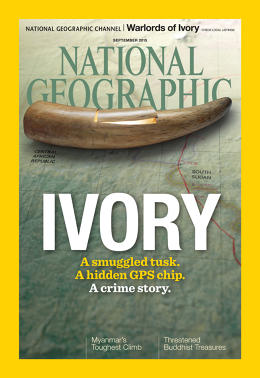How Ingenious pretend Elephant Tusks Helped observe The illegal Ivory change
Implanted with GPS and given to unsuspecting poachers, the tusks inform the story of how poaching cash warlords in Africa.
September 2, 2015
When Bryan Christy, an investigative journalist for national Geographic, wanted to dive into the ivory change—discovering out what happens to the tusks from the 30,000 African elephants that are killed each and every year—he realized that he wouldn’t be able to safely observe the tusks as they traveled from warload to warload in places like South Sudan. So he came up with an ingenious solution: a faux tusk implanted with customized GPS.
Working with an knowledgeable taxidermist who usually works on museum reveals, a staff built a tusk so life like that it landed Christy in jail when he tried to take it through airport security in Tanzania.

After planting the tusks within the black market near Mboki, a small village within the critical African Republic, Christy watched on Google Maps as the tusks slowly traveled against South Sudan, and were held at terrorist hideout. Later, a temperature sensor indicated that the tusks were more than likely buried underground.
In a canopy story for nationwide Geographic‘s September problem known as “tracking Ivory,” Christy tells the story of how poached tusks fund terrorist companies like Joseph Kony’s rebellion team. In 2006, Kony forces moved into Garamba national Park in the Democratic Republic of Congo. at the time, it was residence to 4,000 elephants. Now there are fewer than 1,500, as fighters—and perhaps even the nationwide militia—poach the animals and trade the tusks for fingers.
in poor health-equipped park rangers try to fend off poachers, however are dropping the combat. Christy writes:
. . . in crucial Africa, as I realized firsthand, one thing more sinister is using the killing: Militias and terrorist teams funded partially via ivory are poaching elephants, incessantly outside their residence nations, and even hiding inside nationwide parks. They’re looting communities, enslaving folks, and killing park rangers who get in their method.
lots of the ivory is ending up in China:
A booming chinese heart classification with an insatiable taste for ivory, crippling poverty in Africa, weak and corrupt regulation enforcement, and extra methods than ever to kill an elephant have created a super storm. the outcome: Some 30,000 African elephants are slaughtered annually, more than 100,000 between 2010 and 2012, and the percent of killing shouldn’t be slowing. Most illegal ivory goes to China, where a pair of ivory chopsticks can deliver greater than a thousand dollars and carved tusks promote for hundreds of lots of dollars.
Now, there might be a bit of little bit of hope: China is finally stepping up controls on the ivory change. And possibly African governments—or flora and fauna conservation teams—can take inspiration from Christy and use pretend tusks of their very own to track poachers down.
A documentary concerning the analysis known as Explorer: Warlords of Ivory will air on the nationwide Geographic Channel on Sunday, August 30.
(100)













